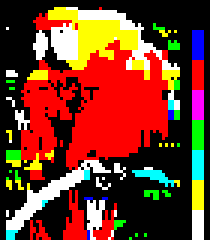Mullard SAA5050


The Mullard SAA5050 was a character generator chip for implementing the Teletext character set. The SAA5050 was used in teletext-equipped television sets, viewdata terminals, and microcomputers, most notably on computers like the Philips P2000 (1980), Acorn System 2 (1980), BBC Micro (1982), and the Poly-1.[1] This chip was also manufactured by Mullard for Philips.[2]
Operation[]
The chip generated appropriate video output for a 7-bit input character code representing the current character on the text line, while keeping track of the effect of any of the various control characters defined by the teletext standard that had previously occurred in that text line, which could be used to change the foreground and background colour, switch to or from the alternate block graphics character set, or various other effects.
Full-screen resolution generated by the SAA5050 was 480×500 pixels, corresponding to 40×25 characters. Each character position therefore corresponded to a 12×20 pixel space. Internally each character shape was defined on a 5×9 pixel grid that was loosely based on the Signetics 2513 character ROM chip. This was then interpolated by smoothing diagonals to give a 10×18 pixel character, with a characteristically angular shape, surrounded to the top and to the left by two pixels of blank space. This gave a particularly stable and flicker-free arrangement on interlaced displays.
The alternate set of 2×3 block graphic characters were created on the same 12×20 pixel grid, so that the top two blocks were each 6×6 pixels, the middle two blocks each 6×8 pixels, and the bottom two blocks again 6×6 pixels (or two fewer in each direction, if the "separated graphics" control character had been sent).
| 0 | 1 | 2 | 3 | 4 | 5 | 6 | 7 | 8 | 9 | A | B | C | D | E | F | |
|---|---|---|---|---|---|---|---|---|---|---|---|---|---|---|---|---|
| 2 | WIKI |